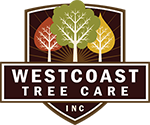From clean air to building materials, trees are an important part of our everyday lives. However, just like all living things, trees eventually die and will show some definite signs when they start to decline. That’s why Westcoast Tree Care would like to provide you with some common symptoms to look out for if you suspect you have a dead or dying tree on your property.
Symptoms Of A Dying Tree
There are many different signs of a sick or dying tree depending on their type. A lack of leaves or a reduction in foliage is one sure sign. Other symptoms include brittle bark, dead branches, and a spongy, decaying trunk.
Leaves & Needles
In the fall and winter, deciduous trees lose their leaves as opposed to evergreen trees who never lose their leaves or needles at once. A symptom of a sick or dying tree is if a deciduous tree drops their leaves or their leaves turn brown and brittle during the growing season. Yellow leaves are another cause for concern. Sick or dying evergreen trees usually have yellow, red or brown needles.
Branches
Dead branches are a good indication of a sick or dying tree. Even worse, dead branches can fall unexpectedly at any time. Branches without bark usually indicate deadwood. This can create a hazardous situation because deadwood can fall unexpectedly at any time without regard to people or property below.
Bark
Another symptom of a sick or dying tree is when it’s bark starts to loosen and fall off. When this happens, a tree becomes vulnerable to disease and wood-boring insects like the Emerald Ash Borer. Brittle bark is another indication your tree is sick or dying.
Trunk
A hollow or spongy trunk is usually a sign of decay. When a tree starts to die, it will start to break down by means of fungal decomposition. Signs to look out for include mushrooms, cavities, insect damage, dead branches and soft, breakable wood.
Roots
Root damage and decay are harder to spot than any other symptom of a sick or dying tree. However, it’s important to keep an eye out for mounds, bulging soil, mushrooms, and fungi around the base of the tree. Visible dead or rotting roots along with an increased lean or a decline in the canopy of a tree can also indicate a sick or dying tree.
Eugene Tree Care
If you spot any of the above-mentioned signs, the best thing you can do is contact a certified arborist to evaluate the health and integrity of your tree. At Westcoast Tree Care, we will be able to tell you if your tree is sick or dying and provide you with advice on the appropriate steps that should be taken to keep your home, property, and loved ones safe. Contact us at 1.800.767.8733 today for a no-cost, no-obligation quote.








